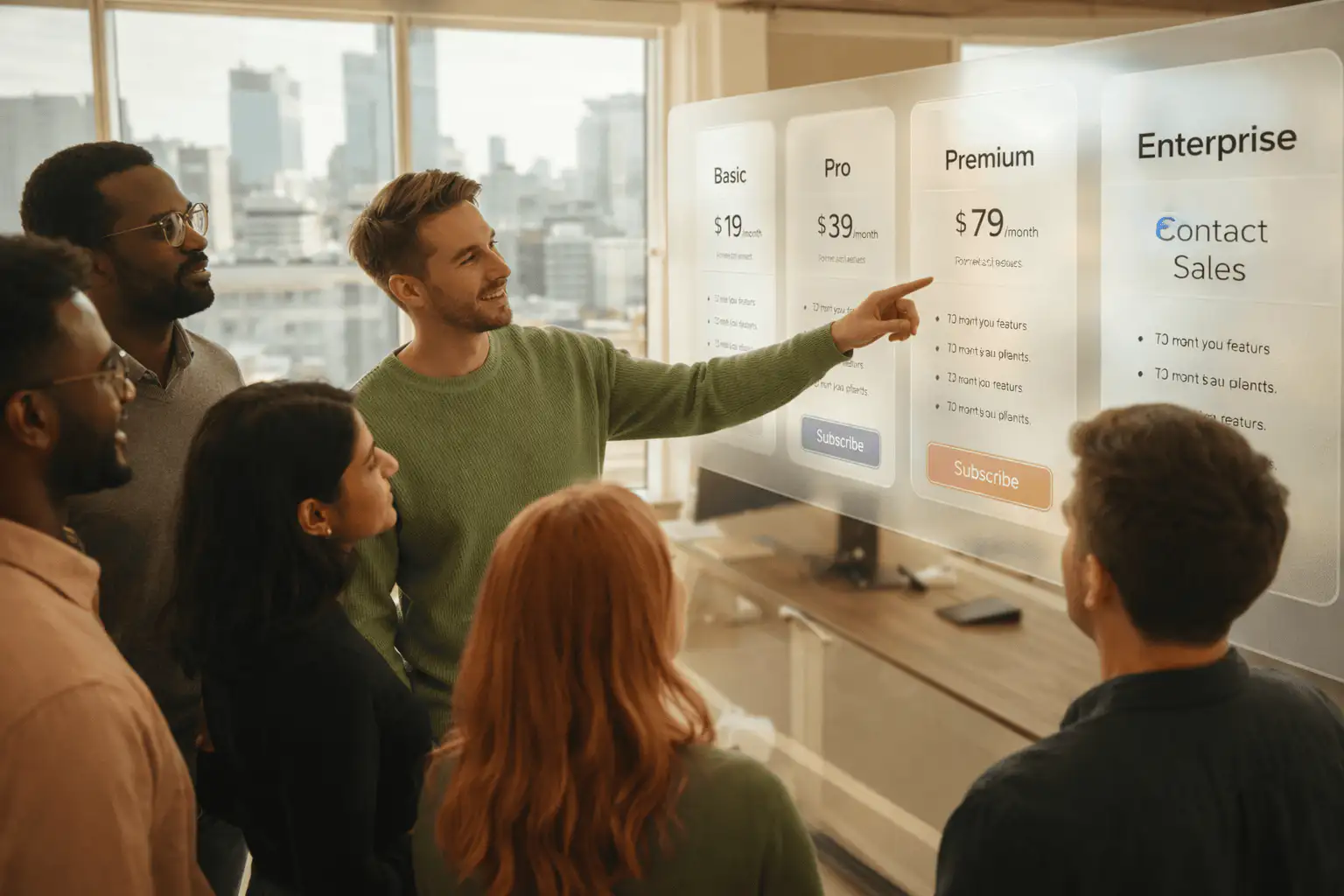Your demo went great. The prospect was impressed. They said "let us think about it" and you haven't heard back in three weeks.
This is the demo paradox: demos generate interest but don't close deals.
Here's why. During a demo, you show what your product can do. After the demo, the prospect goes back to their team and asks: "Yes, but will it work for us? Can they actually deliver? Do we trust this company?"
A case study answers those questions. A demo doesn't.
We've worked with dozens of enterprise AI companies at ThoughtCred, and the pattern is consistent: the ones with strong case studies move deals 23% faster. The ones relying on demos? They're stuck in sales cycles that drag on for months.
Here's the uncomfortable truth most AI companies won't say out loud: your case studies don't need to be from household names. They need to prove you understand the problem and have actually solved it.
The Demo Problem: Why 79% of Demos Don't Convert
Let's start with the data: the average close rate for B2B SaaS demos is just 21%. That means 4 out of 5 demos don't lead to a deal.
Why? Because demos are about your product. Case studies are about your buyer's problems.
During a demo, you're showing features:
- "Here's our dashboard"
- "Here's our reporting"
- "Here's the automation"
After a demo, the prospect thinks: That looks nice in their environment. Will it work in ours?
A case study addresses this directly. It shows:
- A company like ours had this problem
- Here's exactly how they used your solution
- Here's what actually happened (including the messy parts)
- Here's the measurable business impact
The data backs this up:
- Enterprises using case studies close deals 23% faster
- Pipeline growth improves by over 85% when case studies are part of the buyer journey
- AI-powered sales teams using case study-driven insights see 62% higher win rates
- Personalized case studies boost conversion rates by 25%
The difference isn't subtle. It's massive. Yet most AI companies still treat case studies as an afterthought—something you create after you've landed customers, not before.
The Case Study Advantage: What Actually Closes Deals
A case study does something demos can't: it proves you've delivered in the real world.
Here's what case studies accomplish:
1. They reduce buyer hesitation by answering objections upfront
Enterprise buyers are skeptical. They've been burned before. They want to know: What could go wrong? What's the implementation like? Will there be surprises?
A good case study shows the real journey:
- How long implementation took
- What problems came up and how you solved them
- What the customer had to do on their side
- What the actual ROI was (not theoretical ROI)
This builds confidence faster than any demo because it's proof, not pitch.
2. They let sales teams tailor messaging to different stakeholders
A demo is one-size-fits-all. A VP of Sales cares about efficiency. A CTO cares about technical architecture. A CFO cares about ROI.
Case studies can speak to all of them:
- For the VP: "This customer reduced their sales cycle by 35%"
- For the CTO: "The integration took 2 weeks with minimal API customization"
- For the CFO: "They saw 5x ROI in the first 9 months"
A case study gives sales the ammunition to have different conversations with different stakeholders. A demo is fixed.
3. They shorten sales cycles by building confidence faster
Here's the brutal truth: demos often create more questions than they answer. "Can you show me how that works?" "What about this edge case?" "Can we try it with our data?"
One follow-up demo becomes two. Two become three. The sales cycle stretches.
A case study answers most of these questions before they're asked. The prospect reads about a similar company, sees what happened, and moves faster. They're not seeing your product for the first time through a demo. They're evaluating whether to move forward with a vendor they're already confident in.
4. They prove you understand the problem space
Here's the insight most AI companies miss: the case study matters less for what it says about your solution, and more for what it says about your understanding of the buyer's world.
When a prospect reads: "Our customer faced a 40% accuracy issue in their customer service AI, which had two causes: biased training data and insufficient testing for edge cases. Here's how we fixed it..."
They think: "These people get it. They understand the problems that plague AI deployments. They're not just selling software. They've been in the trenches."
That's credibility. That closes deals.
The Uncomfortable Truth About Case Studies
Now let's address the elephant in the room: most enterprise AI companies don't have marquee case studies. They don't have stories about Salesforce or Google or Amazon using their platform.
So they don't create case studies at all.
This is a mistake. A bigger one than you think.
Here's what we've learned at ThoughtCred working with founders: you don't need famous names. You need proof of capability.
The real question isn't "Who are your customers?" It's "Can you explain how you solved their problem?"
An enterprise buyer reading a case study doesn't need the customer name to be recognizable. They need to see:
- A realistic problem (one they might face too)
- Your actual approach (not generic AI buzzwords, but your specific methodology)
- Real results (with caveats and context)
- Evidence that you understand the messy reality of implementation
Let's be clear: if your case study reads like marketing copy ("We deployed our AI and saw 300% improvement and everyone was happy"), nobody will believe it. Enterprise buyers know AI implementation is messy. They know there are false starts. They know things don't go perfectly.
A case study that shows this reality is more credible than one that doesn't.
What Buyers Actually Evaluate in Case Studies
Here's what enterprise buyers are really looking for when they read a case study:
1. Do they understand the problem?
Not "Do they have a solution?" but "Do they actually understand what went wrong?"
A credible case study starts by articulating the problem in detail. Not "The company was struggling with AI accuracy." But "They had a 35% error rate in their automated workflows, caused by three factors: incomplete training data for edge cases, insufficient testing for real-world variance, and a lack of human-in-the-loop validation."
If you can articulate this level of detail, the buyer thinks: "These people know what they're doing."
2. What was your actual approach?
Here's where most case studies fail. They describe the solution in vague terms: "We implemented AI, optimized the model, and trained the team."
A credible case study gets specific: "We conducted a 2-week data audit, identified biased patterns in 40% of the training set, retrained with balanced sampling, implemented a confidence threshold of 85% for autonomous decisions (anything below that goes to humans), and established weekly monitoring for model drift."
This tells the buyer: "They don't just deploy and hope. They have a methodology. They understand the details."
3. What actually happened (not what you hoped would happen)?
Buyers want to know the implementation story:
- Week 1-2: Data validation showed we needed to rebuild training data
- Week 3-4: First model performed well in testing but struggled in production with edge cases
- Week 5-6: We incorporated human feedback, retrained, achieved target accuracy
- Ongoing: Monthly monitoring and model updates
This realistic narrative is more credible than "We deployed and achieved 94% accuracy immediately."
4. What's the business impact (and what's the caveat)?
Results matter, but context matters more. A credible case study says:
"The customer reduced processing time by 40%, cutting their operational costs from $2M to $1.2M annually. This assumes 70% of their workflows fit the AI's design parameters. The remaining 30% still requires manual review."
This is more credible than: "Reduced operational costs by 40% across all workflows."
Why? Because the buyer knows nothing works perfectly on 100% of cases. The company that acknowledges this limitation is proving they understand reality.
Real Case Studies That Actually Close Deals
Let's look at what works:
Example 1: The Approach-First Case Study
Situation: A company was deploying customer service AI but had a 45% error rate due to insufficient edge case handling.
Approach: Instead of starting with a new model, we:
- Audited their existing training data (found 30% of common customer inquiries were missing)
- Built a supervised feedback loop for the first 6 weeks
- Implemented a confidence threshold with human handoff
- Established weekly model reviews with their team
Results: Accuracy improved from 55% to 88%. Processing costs down 35%. But 12% of requests still require human review.
Why it works: The buyer sees the methodology, the realistic timeline, the honest limitations. They think: "This company doesn't overpromise. I trust them."
Example 2: The Transparent Failure Case Study
Yes, really.
Situation: A company tried to fully automate their invoice processing but the AI struggled with format variations across different vendors.
What we learned:
- 15% of invoices use non-standard formats
- Our initial training data didn't include enough examples of these variations
- We needed human review for complex cases longer than expected
What we changed:
- Reduced autonomous processing target from 100% to 85%
- Implemented human review for complex invoices with transparency alerts
- Set up a continuous feedback loop to improve the model
Results: 85% fully automated, 15% flagged for human review, 0% errors. Customer satisfaction increased because they knew what to expect.
Why it works: The buyer knows you understand failure modes. They trust you because you're not pretending AI solves everything.
The Approach Matters More Than the Results
Here's the key insight most AI companies miss: in enterprise buying, how you solved the problem is more important than what the results were.
Why? Because results could be flukes. Approach is proof of capability.
An enterprise buyer reads two case studies:
Case Study A: "We achieved 94% accuracy and reduced costs by 40%."
Case Study B: "The customer faced a biased AI model. We:
- Conducted a data audit and identified gender bias in 23% of predictions
- Resampled the training data to balance protected classes
- Implemented monitoring for bias drift
- Achieved 89% accuracy with <2% bias disparity. Costs down 25%."
Which one convinces them you can deliver?
Case Study B, every time. Because they see your methodology. They understand that you know the hard problems. They believe you can solve them for the next customer too.
The approach is the proof.
The Case Study Process That Actually Works
Here's how to create case studies that close deals:
1. Start with your best customer (not your biggest name)
Pick a customer where:
- You solved a real, complex problem
- You learned something in the process
- The customer is willing to be a reference (doesn't need to be publicly named)
- The implementation was realistic, not perfect
2. Interview deeply about the approach
Don't ask: "How did we do? Are you happy?"
Ask:
- What was the problem when we started?
- What surprised you during implementation?
- Where did we struggle?
- How did we solve it?
- What would you do differently?
The messy answers are the ones that make good case studies.
3. Structure around the approach
Problem → Our Methodology → Results with Context
Not: Problem → Results → Testimonial
4. Get specific about implementation
Timeline, data requirements, team involvement, changes they had to make—this is what buyers care about.
5. Include honest limitations
"This approach works well for use cases like theirs. It doesn't work for [specific scenario] and here's why."
Buyers trust honesty more than perfection claims.
Why Case Studies Beat Demos: The Buyer's Journey
Here's what's actually happening when an enterprise buyer decides to move forward:
Stage 1: Awareness → LinkedIn post or blog mentions your approachStage 2: Consideration → Prospect reads case study, understands your methodologyStage 3: Evaluation → Sales request case study relevant to their use caseStage 4: Decision → They schedule a demo (now they know what to look for)Stage 5: Close → Deal moves fast because expectations are set by the case study, not the demo
Notice where the demo is. It's at stage 4, not stage 1. By the time they see your demo, they've already decided if you understand their world.
A case study determines if you understand their world.
The Real Insight
Demos show your product. Case studies show your capability.
Enterprise buyers trust capability more than features. They've seen impressive demos from companies that couldn't deliver. They've been burned by solutions that looked perfect in presentations but failed in reality.
A case study—especially one that's honest about approach, methodology, and realistic limitations—is proof you've been through this before. Proof you understand the problems. Proof you can deliver.
This is why companies using case studies close deals 23% faster. This is why their win rates go up 62%. This is why pipeline growth accelerates 85%.
It's not because the case studies are flashy. It's because they're credible.
Ready to Build Case Studies That Actually Close?
If your sales team is running on demos alone and your sales cycle is dragging, it's time to build case studies that move deals.
ThoughtCred works with enterprise AI companies to develop case studies that prove capability, establish methodology, and build credibility with enterprise buyers. We help you translate customer success into evidence of your approach and thinking—the kind of evidence that closes deals.
Let's talk about your case study strategy — or explore our success stories to see how enterprise AI companies have accelerated their sales cycles through strategic case study development.



.webp)



.svg)